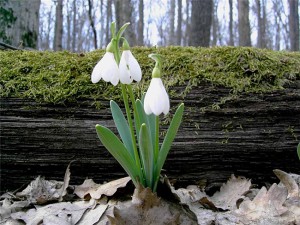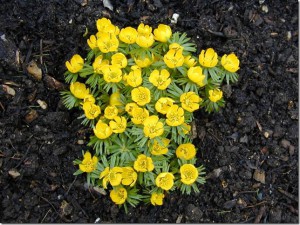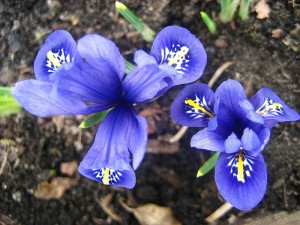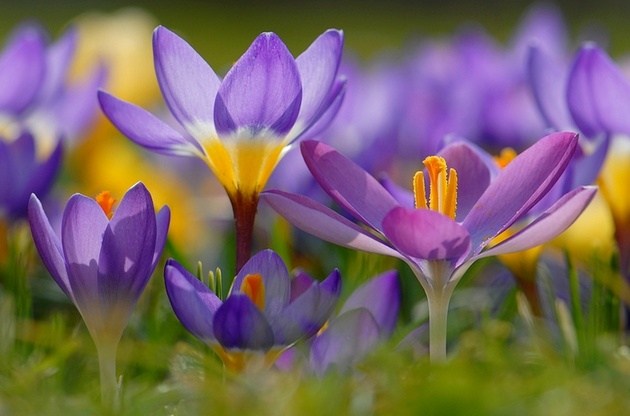First spring flowers. Plants that bloom in early spring
We are all looking forward to spring with great impatience, enjoying the very first rays of the warm sun, the first thawed patches and streams. But the first ones to bloom probably cause special joy. The appearance of these small but brave messengers of spring indicates that spring is finally and irrevocably knocking on our doors..
Early flowering bulbous
The most numerous and popular among early spring flowers are, of course, all kinds of bulbous plants. As a rule, they are planted in the fall, and the first flowers can already be admired in those regions where spring comes early.
1. When you talk about spring and the first plants, the image of a beautiful snow-white flower certainly comes to mind. snowdrop. This flower resembles an elegant drop that forms under the snow. Galanthus (the second name for snowdrops) appears in early March, as soon as the snow melts in the garden. The French call this delicate touching flower a snow bell, the British call it a snow drop. And of course, there is a wonderful legend that tells about the goddess Flora, who distributed robes to flowers. Snowdrop got the snow-white one, which he shared with the snow, and so they are still friends - white snow and white snowdrop
2. Vesennik, or erantis, are bright golden-sunny flowers that bloom in a still slightly dim garden, giving a good spring mood to everyone who catches their eye on them. Its flowering begins in March-April, and surprisingly, it is not at all afraid of late snowfalls!
3. Amazing, fun and colorful crocuses stand out for their friendly and abundant flowering. The ancient Greeks considered the crocus the flower of the dawn goddess Aurora, the flower of awakening nature. These small flowers are appropriate almost everywhere: they are planted in flower beds, on clubs, under trees and bushes, and even in containers.
4. Siberian Scilla pleases the eye already in early March. As soon as the snow melts, here and there you can see bright blue scylla flowers, which many mistakenly confuse with snowdrops. And if you use your imagination, you can easily notice that the blue field of woods resembles a lake in which the spring sky is reflected.
Herbaceous perennials
Herbaceous perennials blooming early spring, not so many, but each of them is remarkable in its own way.
- Name hellebore speaks for itself, everyone here understands that it blooms in the cold. In its homeland in Transcaucasia, it blooms in winter, at the end of February. This wonderful evergreen perennial is extremely unpretentious and disease resistant. In Europe it is often called the “Rose of Christ” because the hellebore often blooms during the Easter holidays;
- primrose They are distinguished by great diversity; they bloom mainly from April (and in warmer regions - from March), abundantly and for a long time. Moreover, in some species it is possible to re-bloom in late summer - early autumn. Read more about this beautiful flower in!
- evergreen periwinkle It retains its leaves even under the snow, it sends out young shoots as soon as the soil begins to thaw, and in April it is covered with numerous pale blue flowers. In addition to traditional blue ones, varietal plants can have white, lilac and even red flowers, both simple and double.
Spring is a truly magical time of year: the sun begins to warm up, birds return from warmer climes, and everything around blossoms. Probably, everyone at least once in their life was interested in what flowers bloom first in the spring, of course, except for snowdrops, the name of which speaks for itself, and is known to many, if only thanks to the fairy tale “12 months”. In this article you can find the answer to your question.
An ordinary snowdrop (aka lily of the valley). This is a low plant that is the first to come to life after spring in forests and gardens. A few elongated leaves appear first, then flowering begins. Flowers are white with drooping bells. The plant is not afraid even of snow, frosts and very cold temperatures; sometimes lilies of the valley make their way even through a fairly large layer of snow.
This is a low plant that is the first to come to life after spring in forests and gardens. A few elongated leaves appear first, then flowering begins. Flowers are white with drooping bells. The plant is not afraid even of snow, frosts and very cold temperatures; sometimes lilies of the valley make their way even through a fairly large layer of snow.
Chionodoxa. These flowers are also called “Glory of the Snows”. There are three Chionodoxa different types, and each has its own characteristics. The bulbs of this flower are frost-resistant, and they are very easy to grow due to the fact that no special effort is required. These flowers are also found in the mountains, at an altitude of about 2 km. Chionodoxa begins to bloom in early spring and its flowering lasts about two weeks. On a thin stem there are about 10-15 bells looking up, forming like a kind of cap.
These flowers are also called “Glory of the Snows”. There are three Chionodoxa different types, and each has its own characteristics. The bulbs of this flower are frost-resistant, and they are very easy to grow due to the fact that no special effort is required. These flowers are also found in the mountains, at an altitude of about 2 km. Chionodoxa begins to bloom in early spring and its flowering lasts about two weeks. On a thin stem there are about 10-15 bells looking up, forming like a kind of cap.
 Also called spring flowers, these flowers are known for their honey-like aroma and bright yellow flowers surrounded by bronze-green leaves. They usually grow in small bushes, but single flowers may appear in early spring.
Also called spring flowers, these flowers are known for their honey-like aroma and bright yellow flowers surrounded by bronze-green leaves. They usually grow in small bushes, but single flowers may appear in early spring.
 The flowers of this plant are most often found in white, but yellow and light blue shades are also quite common. Iris reticulum is the earliest variety of irises; flowering occurs from February to April.
The flowers of this plant are most often found in white, but yellow and light blue shades are also quite common. Iris reticulum is the earliest variety of irises; flowering occurs from February to April.
Crocuses Crocuses are very beautiful flowers, regardless of their variety. They are considered attractive due to their colorful flowers opening while the ground is still covered in snow. The name of the flower “crocus” comes from the Greek word “kroki”, which translates as “thread”. Flowers have a thread-like stigma. They begin to bloom in late February or early March. Crocuses grow 8-15 cm in height and produce yellow, blue-violet or white flowers in spring.
Crocuses are very beautiful flowers, regardless of their variety. They are considered attractive due to their colorful flowers opening while the ground is still covered in snow. The name of the flower “crocus” comes from the Greek word “kroki”, which translates as “thread”. Flowers have a thread-like stigma. They begin to bloom in late February or early March. Crocuses grow 8-15 cm in height and produce yellow, blue-violet or white flowers in spring.
material prepared by Daria Trubitsina
Spring flowers in the video collection:
With the first rays of spring and the melting of snow, the first flowers awaken. In addition to snowdrops, other early flowering plants are harbingers of spring.
Instructions
- The first spring flower is Chionodoxa luciliae. Due to its early flowering, this plant also has another name - Glory of Snows. A small (up to 15 cm) bulbous plant breaks through the melting snow and blooms for two weeks. On a thin stem there are 10-15 flowers with a diameter of up to 3 cm, externally resembling wide bells. Bright blue, blue, lilac flowers and linear emerald leaves adorn the mountain slopes and alpine meadows at an altitude of about 2 km.
- The most famous (and therefore very rare today) primrose is the Common Snowdrop (Galanthus nivalis). The snowdrop is recognizable by its linear leaves, which it produces first, and its white drooping bells. This delicate frost-resistant plant is listed in the Red Book. Therefore, you should think carefully before picking these primroses.
- The harbinger of spring in our latitudes is Vesennik or Eranthis hyemalis. It is a single bush up to 30 cm high, on which there are many yellow cup-shaped flowers of medium size. Vesennik's leaves are thin and heavily dissected. The plant has a rich honey aroma.
- Almost simultaneously with Vesennik, the purple, white, yellow and bluish flowers of the Iris reticulata bloom. The plant has thin linear leaves, produces a pleasant aroma and blooms from February to April. The reticulated iris rises above the ground by only 8-15 cm, half of which is the length of the flowers.
- In early spring, Caltha blooms in flower beds, parks and meadows. At the beginning of April you can see it everywhere yellow flowers with five round petals. The leaves of Marigold are dark green, wide, heart-shaped.
- Another bulbous primrose is the spring whiteflower (Leucojum vernum). The edges of mountain beech forests are decorated with a plant up to 20 cm in height with white drooping flowers in the form of wide bells, which can be single or paired. You can recognize the spring whiteflower by the characteristic green or yellow color of the tips of the petals. The perianth sparkles with crystal whiteness against the background of green, broadly lanceolate leaves.
- The trees also have their own primroses. They are wind pollinated and therefore bloom before releasing their leaves. This happens to ensure that nothing interferes with pollination. Trees such as alder and willow are the first to bloom. Their pollen-rich inflorescences are a salvation for the first insects in search of food.
KakProsto.ru
Why do plants bloom?
The flowering period is the process of sexual reproduction of plants, which begins with the formation of flower primordia in the buds, followed by their appearance, pollination and flowering, resulting in the appearance of seeds and fruits, allowing the plants to continue their genus. At the same time, flowering time for different plants occurs at different periods of their life cycle. For example, the first flowering of annual plants begins early, after the sprout sprouts, becomes established in the soil and produces a pair of leaves. Other plants (this primarily applies to trees), before the first flowering begins, develop a root system and accumulate nutrients so that flowers and seeds develop normally.
Annual and biennial plants bloom once in their lives and die, having spent all their strength and energy on this process. True, among such flowers there are also perennial plants, for example, the first flowering of Puya Raymondia, growing in the Andes, begins at the age of one hundred and fifty years.
As for perennial herbaceous and woody plants, their first flowering begins no earlier than they reach a certain age: in herbs, the beginning of flowering ranges from two to five years, while the flowering of trees begins in the twentieth, and in some species even in the thirtieth year life.
Unlike annual and biennial plants, flowering of perennial plants occurs many times. Some of them are characterized by periodicity (most fruit trees bloom once every two years, and oak - once every five to seven years), while others have a continuous flowering period (especially this refers to tropical plants, such as the coconut palm).
How plants bloom
Inside each flower there is a pistil (the part of the flower where, after fertilization, seeds are formed that begin to grow and turn into fruits) or a stamen (it contains the pollen necessary for fertilization, it is also called the male reproductive organ), or both.
Seeds in the pistil begin to form no earlier than the pollen from the stamens reaches the stigma of the pistil. But for this, pollination is necessary. If it does not happen on time (and it happens during flowering), the pistil will dry out and reproduction will not occur.
Pollen
It is interesting that if a flower has both a pistil and a stamen, it is rarely pollinated by its own pollen: plants almost never allow this. The reason is simple: in order to form a fruit from which strong and strong plants will sprout, pollen must be obtained from a neighboring flower (this process is called cross-pollination).
Therefore, when it is time to bloom, in order to avoid the possibility of pollination by its own pollen, the stamens and pistils inside one flower mature into different times flowering. For example, the pistil ripens first, and after it is pollinated by pollen from a neighboring flower, the anthers of the stamen open. It is because of this that we can observe the flowering of perennial plants for about two to three weeks a year.
Wind-pollinated flowers
There are plants in which stamens and pistils are located not only in different flowers, but also in “houses”: the flowers of some plants have only pistils, while others have stamens. Such plants are called dioecious and include willow, poplar, date palm, hops, hemp, and nettle.
This means that in order to pollinate the pistil during flowering, pollen must fly from one flower to another, and the desired flower may well be several kilometers away. Dioecious plants have adapted to this quite well in an original way: some use the wind, others use insects.
Wind-pollinated plants are interesting because they never have bright and fragrant flowers, which, firstly, would interfere with the movement of pollen, and secondly, would attract insects that could easily break the thin stamen filaments with anthers. Therefore, instead of petals, such plants usually have inconspicuous scales that protect them from negative influences environment, or no petals at all.
Interestingly, plants even take into account the inconsistency of air currents, so those that are pollinated by the wind usually grow close to each other: birch and pine trees form forests, corn, rye and other cereal crops occupy huge fields. All flowers that are pollinated by air masses create a lot of pollen; for example, just one adult corn sprout contains about 50 million pistils.
Therefore, no matter which direction the wind blows during flowering, pollen will still find suitable flowers. Moreover, plants do not wait until the pollen is directly in the flower, but catch them with the long and fluffy stigmas of the pistils: when the pollen ends up between the hairs, it gets entangled in them.
There is one more circumstance that facilitates the work of air flows: plants that use wind for pollination almost always bloom in early spring, before the leaves appear, which, by retaining pollen, could interfere with the process.
Insects and pollination
It should be noted that this method of pollination is still not suitable for many plants, so they prefer to deliver their pollen to other flowers with the help of winged insects (bees, bumblebees, butterflies), luring them with honey, bright color and incredibly attractive aroma.
It is interesting that plants are quite picky when choosing the insect that is suitable for them: some prefer bees, others prefer bumblebees, and others prefer butterflies. Therefore, depending on preferences, they not only create the shape of flowers, inside of which only a certain type of insect can be found, but also open their petals while this insect is awake (for example, all night flowers are white in color, since only this color is visible in darkness).
Plants that are characterized by early spring bloom, which is why pollination occurs with the help of bees, are white, yellow or blue in color - bees see only these colors. Closer to summer, a lot of red flowers appear - this tone is attractive to butterflies, which appear much later than bees. It is worth noting that white color is attractive to absolutely all types of insects.
As for the honey that insects hunt for, it is hidden so deep in the flower that a bee, in order to get to it during flowering, needs to get between the pistils and stamens, smearing itself in pollen. After this, flying to another plant, making its way for the next portion of honey, it leaves some of the pollen in the flower.
The time when plants bloom
The timing of flowering primarily depends on the type of plant, the amount of pollen and flowers, climatic conditions and soil quality. For example, poor or too abundant nutrition slows down flowering and reduces the quality of flowers.
Flowering time for fruit trees in temperate latitudes of the northern hemisphere usually begins in mid-April and the flowering season lasts until mid-May. If, due to climatic conditions, plant flowering is observed in late summer or early autumn, this does not lead to anything good.
The secondary appearance of flowers on trees will deprive the gardener of a harvest next year, since flowers will not appear in this place after winter: the plant will spend additional nutrients on the flowering of trees, the formation of seeds or seeds, which is why it will become less winter-hardy and will endure the winter more difficult. Since this phenomenon can be prevented by at the moment In order to preserve nutrients in the tree, gardeners are advised to pick flowers and buds from it.
You can observe flowering plants throughout the warm season. To this end, many gardeners, when planning the landscape of their suburban area, take into account the flowering season and strive to ensure that the gardens continue to bloom as long as possible. To do this, they use specially compiled flowering calendars for tuberous and bulbous plants, which indicate the period and time of flowering of a particular species.
AwesomeWorld.com
Help!!! What is the significance of early flowering for a dandelion?
Elena
Why primroses bloom so early is not very clear. Perhaps to avoid competition for pollinators or to be the first to “develop” some other resources. But most likely, the answer lies in the history of these plants. There is an assumption that many of them appeared in the harsh climate of the Alpine mountain belt or in similar conditions that arose more than once during glaciations. In order to have time to produce seeds during the short summer, plants in these conditions, like our primroses, begin to develop while still under the snow. Closely related species, for example, goose onion, scilla, corydalis, which are among the first to bloom in our country, still grow in the mountains.
Ivannych
Dandelion (Taraxacum officinale Weber). Widely distributed in Europe, Asia and North America. In many areas it blooms so profusely that in some years the fields and meadows present an almost continuous golden-yellow carpet. Due to its appearance in early spring, before fruit trees begin to bloom, dandelion has great value in beekeeping. In some years it provides a lot of nectar and a lot of pollen, when the bees need abundant food to raise brood.
Dandelion can significantly strengthen families, thereby increasing the main bribe later. In some areas, dandelion honey is sometimes sold on the market. In many areas, it commands a higher price than honey from fruit tree flowers. Although dandelion honey does not have a subtle taste, it is still used in baking. On many farms in Ontario and Quebec, Canada, more honey is harvested from dandelions in early spring than from any other plant. It appears to be spreading rapidly in Canada and the United States and is playing an increasingly important role as a honey plant.
Bees visit the dandelion: in May for two weeks, and if the weather is warm, even longer. The honey is bright yellow to dark amber in color (slightly darker than goldenrod). Honeycombs built during the honey harvest period from dandelions have a very beautiful bright yellow hue; even old honeycombs become yellowish. Freshly harvested honey is characterized by a strong aroma and taste of the plant. Ripe honey acquires a pleasant taste, although people accustomed to more tender honey, consider it too harsh.
Dandelion is not only beautiful, but also useful. Trying to destroy it, if it were possible, would be a big mistake. There can be no doubt about the beauty of its flowers, which are a model of symmetry. It is not harmful in hayfields, and when grazing cows it increases the amount of milk and improves its quality.
How do pine, spruce, cedar and other conifers bloom?
http://www.youtube.com/watch?v=ZfRfms3BSbQCedar has cones that look like a flower - 2 years ago
navik
Conifers, in our understanding, do not bloom, since they are not flowering plants, but gymnosperms. However, flowering is still not alien to them, only coniferous flowers do not look like flowers, but like cones or spikelets, which usually do not smell. Since conifers are wind pollinated, they usually bloom before the leaves on deciduous trees bloom - otherwise the foliage could interfere with the transfer of pollen by the wind. This is how a pine tree blooms: 
lorasvet
Coniferous trees, in the generally accepted understanding of flowering, do not have such an attractive appearance as, for example, the blossoming flowers of a cherry or apple tree. Coniferous flowers are similar in appearance to yellow spikelets (male inflorescences) or pinkish cones (female inflorescences). They usually bloom in May before young leaves appear on deciduous trees. Usually flowers do not smell of anything. Pollen from inflorescences is carried over long distances by the wind and “scares” ignorant people who see a threat to the health of others by observing yellow puddles and unusual dust on the roadsides.
Mirra-Mi
Flowers on coniferous trees very peculiar, not similar to other colors that we are used to seeing. But, like all flowers, they are beautiful. Amateur photographers, of course, also appreciate them and capture them in their photographs. thanks to them, we can also see how various coniferous trees bloom, which we may have never seen before.
Conifers include:
Cedar colors A:

Veresk
Coniferous trees always bloom in early spring. Of course they are not covered beautiful buds flowers, their cones perform this role. When I saw the amazing flowering of the Siberian larch, I didn’t believe it, I thought it was a photo montage, beauty!
Young oval-spherical cones (male cones) appear on bottom side branches of conifers, they also secrete abundant yellow pollen, the pollen falls on the red-green cones (female).
This is how larch blooms:

Lilka-g
Coniferous trees do not have flowers, but when spring comes, they begin to bloom with the help of cones.
Although these trees do not have flowers, they bloom just as beautifully as trees and plants that have flowers. In addition, coniferous trees have a very good smell. When you walk not far from these trees, you immediately smell the smell of spring.

Strymbrym
Flowering of coniferous trees begins early, before the flowering of deciduous trees. The fact is that pollen from coniferous plants is carried exclusively by the wind and in order for this process to be successful, it requires open space. Anther spikelets are formed, which then open and the pollen is dispersed.
12NiNeL14
Coniferous trees mainly bloom in the spring, and cedar in Siberia and Lebanon begins to bloom in the autumn. The flowers of coniferous trees are unusual, more like pot-bellied barrels, in the form of cones. Siberian and Lebanese cedar are different, the cones are different in color and shape. 
elena-kh
I’ll show you in pictures how different coniferous plants bloom. It's very beautiful.
This is how a pine tree blooms:

stalonevich
Do coniferous trees bloom? Of course they bloom! But only their flowers are different from those we are used to, although this makes them even more beautiful and unique. See a small selection of photographs of coniferous trees blooming: 
zagadka2030
Not every person has not only seen, but even knows that coniferous trees bloom with beautiful flowers.
This is how a pine tree blooms:

The first spring flowers are harbingers of spring and warmth. What flowers are considered primroses?
– a perennial herbaceous plant of the Ranunculaceae family. The name comes from the Greek - " spring flower" Blooms one of first spring flowers, as soon as the first thawed patches appear. Erantis is called the harbinger of spring.
Following the Erantis, a snowdrop peeks out from under the snow.
 - plant of the family iris. It got its name from the Greek “Kroke” - thread, because. dried crocus stigmas look like threads. According to legend, saffron arose from drops of the blood of the young man Krok. Krok competed with the god Hermes in discus throwing, and Hermes accidentally killed him. The first ancient saffron had yellow shades, and it received blue, pink and white colors as a result of selection. The second name - saffron - comes from Arabic word"yellow". Saffron has been used as a seasoning, incense, dye, medicinal plant. Interestingly, in ancient China, no one except the emperor had the right to wear saffron-colored clothes. And in some countries, women used crocus to ease childbirth.
- plant of the family iris. It got its name from the Greek “Kroke” - thread, because. dried crocus stigmas look like threads. According to legend, saffron arose from drops of the blood of the young man Krok. Krok competed with the god Hermes in discus throwing, and Hermes accidentally killed him. The first ancient saffron had yellow shades, and it received blue, pink and white colors as a result of selection. The second name - saffron - comes from Arabic word"yellow". Saffron has been used as a seasoning, incense, dye, medicinal plant. Interestingly, in ancient China, no one except the emperor had the right to wear saffron-colored clothes. And in some countries, women used crocus to ease childbirth.
Adonis (Adonis)- a perennial herbaceous plant of the family. Ranunculaceae. Large adonis flowers glow golden in the sun. Adonis received its Latin name in honor of Adon, the Phoenician and Assyrian sun god, who died every year and was resurrected every spring, like this flower. There is another version about the origin of the name from Greek mythology. Adonis disobeyed the goddess Aphrodite, who forbade him to hunt wild animals, and was mortally wounded by a boar. Aphrodite, grieving for her beloved young man, turned Adonis into a beautiful flower that is reborn every spring.
 – the name of this plant comes from the word “early, first”, because primrose is one of the very first spring flowers. Primrose resembles a bunch of golden keys. In Scandinavian mythology, primrose is the key of the goddess Freya, with which she unlocks the doors of spring. According to another belief, these are the keys to heaven, which St. Peter dropped to the ground. According to Celtic belief, primrose was considered the key to marriage and was part of the love potion.
– the name of this plant comes from the word “early, first”, because primrose is one of the very first spring flowers. Primrose resembles a bunch of golden keys. In Scandinavian mythology, primrose is the key of the goddess Freya, with which she unlocks the doors of spring. According to another belief, these are the keys to heaven, which St. Peter dropped to the ground. According to Celtic belief, primrose was considered the key to marriage and was part of the love potion.
 Lungwort (pulmonaria)- a small plant of the family. borage Russian name came from the taste and smell of flowers - sweet, honey. Pulmonaria received its Latin name due to the use of plant leaves in the treatment of pulmonary diseases. In the lungwort inflorescence you can simultaneously see blue and red flowers, hence the legend that blue flowers- Adam, and the red ones - Eve. In fact, young flowers are pink, and old ones are blue.
Lungwort (pulmonaria)- a small plant of the family. borage Russian name came from the taste and smell of flowers - sweet, honey. Pulmonaria received its Latin name due to the use of plant leaves in the treatment of pulmonary diseases. In the lungwort inflorescence you can simultaneously see blue and red flowers, hence the legend that blue flowers- Adam, and the red ones - Eve. In fact, young flowers are pink, and old ones are blue.

